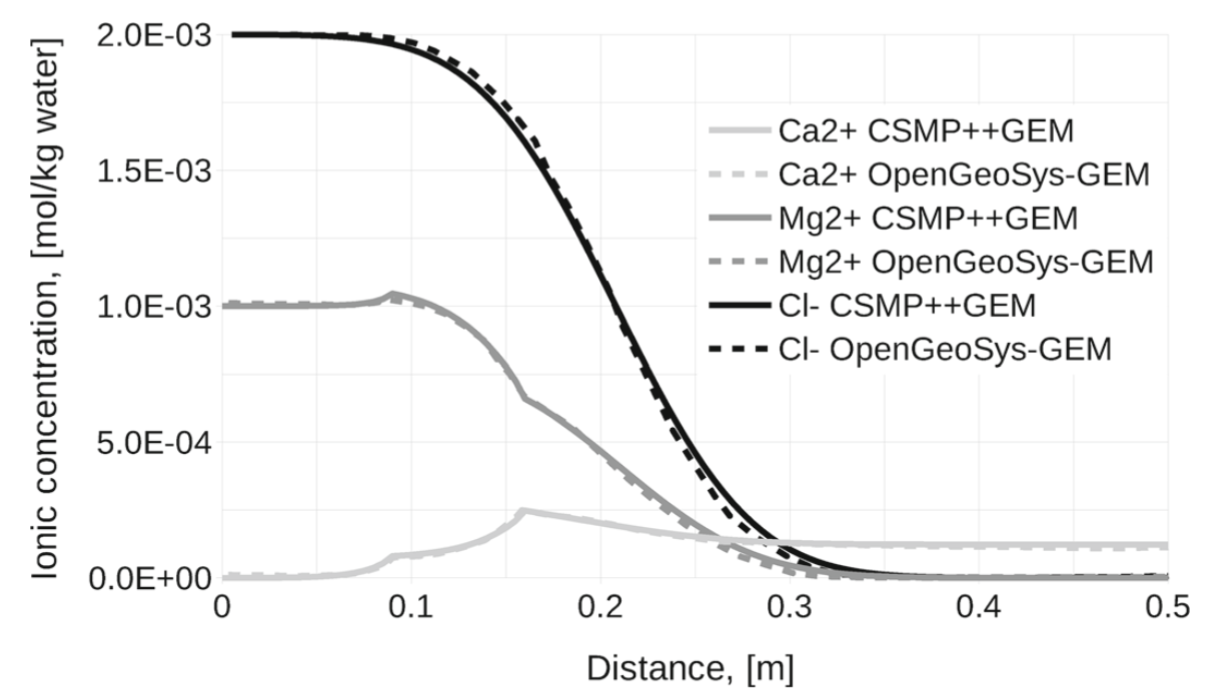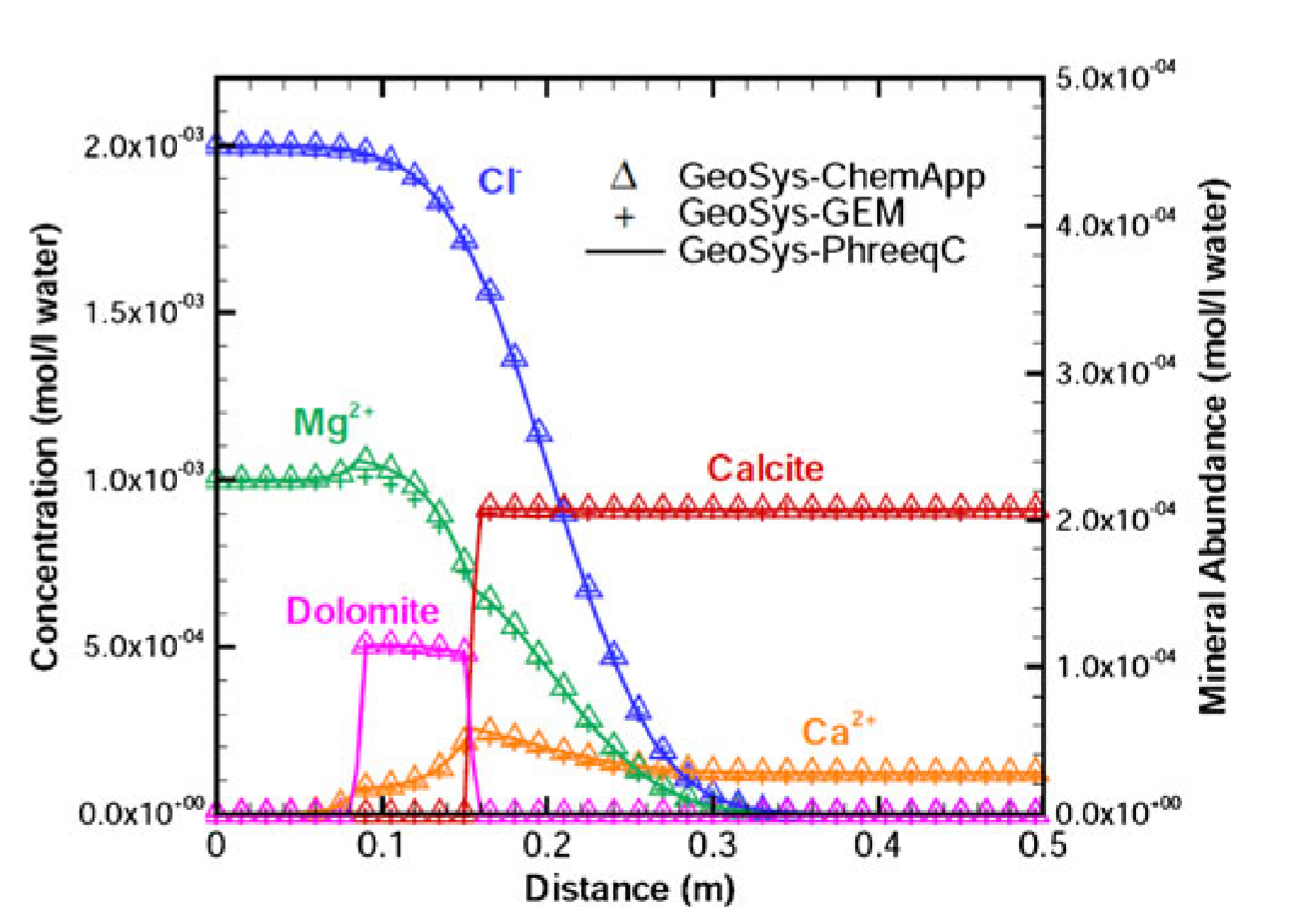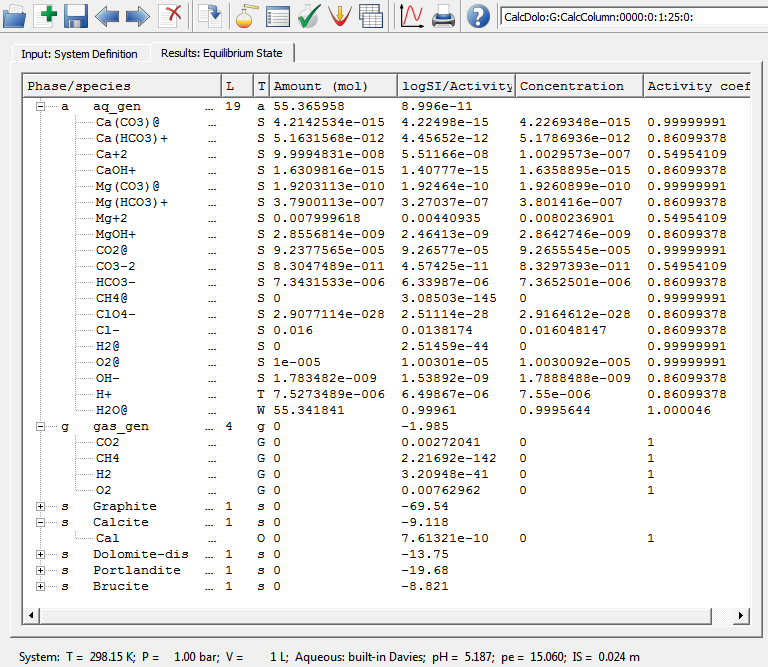 GEM-Standalone: Examples
GEM-Standalone: Examples
xGEMS
-
Run the demo examples in your browser (no installation required)
-
Checkout the xgems-jupyter repository of examples using xgems in jupyter notebooks
-
Examples both in C++ and Python can be found in the code repository. * Examples both in C++ and Python can be found in the code repository.
The GEMS3K I/O files used in the gemcalc and node-gem test examples were exported using GEM-Selektor v.3 from the CalcDolo modeling project (included in the GEM-Selektor installer). This small, simple project demonstrates GEMS3K I/O file structures.
Reactive Transport in a Calcite Column (xGEMS in Python)
A demo reactive transport modeling of the calcite–dolomite benchmark1 2 using xGEMS can be found in the repository
GEMS3K
Batch equilibrium calculations
- See
standalone/gemcalc/main.cppfor an example using DCH, IPM, and DBR input files. - Results are stored in DBR files or optionally in a text dump file.
Reactive Transport in a Calcite Column (GEMS3K TNode in C++)
Coupling with transport codes
- See
standalone/node-gem/main.cppfor an example of integrating GEMS3K with a multi-node mass transport solver. - Chemical data and parameters are exchanged dynamically in memory.
This example models a hypothetical porous column filled with an inert material containing small amounts of reactive calcite. A Ca-poor MgCl₂ solution enters one end of the column as an infinite source, while the opposite end serves as an infinite sink. As fluid flows through the column (assuming instantaneous mineral-water reactions), two key reaction fronts develop:
- Calcite dissolves, and dolomite precipitates.
- Dolomite dissolves, leaving no reactive minerals in the column.
To define this system, only two initial chemical states are required:
- Initial column composition: Stable calcite with trace amounts of Mg and Cl.
- Source composition: MgCl₂ solution.
Both are provided in the CalcDolo project.
Initial Column Composition
The CalcDolo:G:CalcColumn:0001:0:1:25:0 SysEq record represents the initial column chemistry (excluding inert material).
Bulk Composition
Property Name Quantity Units
bi_ C 0.00035 M
bi_ Ca 0.00025 M
bi_ Cl 2e-07 M
bi_ H 110.684 M
bi_ Mg 1e-07 M
bi_ O 55.3428 M
Equilibrium Speciation
At 1 bar and 25°C, equilibrium calculations produce the following speciation:
Here, partial calcite dissolution (isolated from atmospheric air) results in a slightly alkaline, low-ionic-strength solution.
Source Solution Composition
The CalcDolo:G:CalcColumn:0000:0:1:25:0 SysEq record defines the MgCl₂ source solution:
Bulk Composition
Property Name Quantity Units
bi_ C 0.0001001 M
bi_ Ca 1e-07 M
bi_ Cl 0.016 M
bi_ H 110.684 M
bi_ Mg 0.008 M
bi_ O 55.3421 M
Equilibrium Speciation
At 1 bar and 25°C, equilibrium calculations produce:
Here, calcite and dolomite are both strongly undersaturated, the solution is weakly acidic, and it has a significant ionic strength (0.024 m).
File Export and Location
- The initial column composition was exported as:
CalcColumn-dch.datCalcColumn-ipm.dat-
CalcColumn-dbr-0-0001.dat -
The source solution composition was exported as:
CalcColumn-dbr-0-0000.dat- (DCH and IPM files remain unchanged, as only the bulk composition differs.)
All exported files can be found in:
- tp_test/ subfolder of standalone/gemcalc-build/
- tp_test/ subfolder of standalone/node-gem-build/
In gemcalc-build, files contain comments and all data fields, while in node-gem-build, files are optimized for performance.
-
A. Yapparova, T. Gabellone, F. Whitaker, D. A. Kulik, and S. K. Matthäi, "Reactive transport modelling of dolomitisation using the new CSMP++GEM coupled code: Governing equations, solution method and benchmarking results," Transport in Porous Media, vol. 117, no. 3, pp. 385--413, 2017, doi: 10.1007/s11242-017-0839-7. ↩
-
H. Shao, S. V. Dmytrieva, O. Kolditz, D. A. Kulik, W. Pfingsten, and G. Kosakowski, "Modeling reactive transport in non-ideal aqueous--solid solution system," Applied Geochemistry, vol. 24, no. 7, pp. 1287--1300, 2009, doi: https://doi.org/10.1016/j.apgeochem.2009.04.001. ↩



